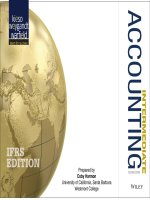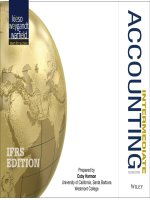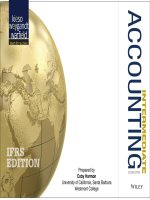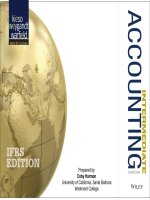Lecture Intermediate accounting (IFRS 2nd edition): Chapter 9 - Kieso, Weygandt, Warfield
Bạn đang xem bản rút gọn của tài liệu. Xem và tải ngay bản đầy đủ của tài liệu tại đây (1.59 MB, 67 trang )
9-1
PREVIEW OF CHAPTER
9
Intermediate Accounting
IFRS 2nd Edition
Kieso, Weygandt, and Warfield
9-2
9
Inventories: Additional
Valuation Issues
LEARNING OBJECTIVES
After studying this chapter, you should be able to:
1. Describe and apply the lowerof
costornet realizable value rule.
5. Determine ending inventory by applying
the gross profit method.
2. Explain when companies value
inventories at net realizable value.
6. Determine ending inventory by applying
the retail inventory method.
3. Explain when companies use the
relative standalone sales value method
to value inventories.
7. Explain how to report and analyze
inventory.
4. Discuss accounting issues related to
purchase commitments.
9-3
LOWEROFCOSTORNET REALIZABLE
VALUE (LCNRV)
A company abandons the historical cost principle
when the future utility (revenueproducing ability) of
the asset drops below its original cost.
9-4
LO 1
LCNRV
Net Realizable Value
Estimated selling price in the normal course of business less
9-5
u
estimated costs to complete and
u
estimated costs to make a sale.
ILLUSTRATION 91
Computation of Net
Realizable Value
LO 1
LCNRV
Net Realizable Value
9-6
ILLUSTRATION 92
LCNRV Disclosures
LO 1
LCNRV
ILLUSTRATION 93
Determining Final
Inventory Value
Illustration of LCNRV: JinnFeng Foods computes its
inventory at LCNRV (amounts in thousands).
9-7
LO 1
LCNRV
Methods of Applying LCNRV
9-8
ILLUSTRATION 94
Alternative Applications
of LCNRV
LO 1
LCNRV
Methods of Applying LCNRV
uIn most situations, companies price inventory on an itemby
item basis.
uTax rules in some countries require that companies use an
individualitem basis.
uIndividualitem approach gives the lowest valuation for
statement of financial position purposes.
uMethod should be applied consistently from one period to
another.
9-9
LO 1
Recording Net Realizable Value
Illustration: Data for Ricardo Company
Cost of goods sold (before adj. to NRV)
Ending inventory (cost)
Ending inventory (at NRV)
Loss
Method
COGS
Method
9-10
Loss Due to Decline to NRV
€108,000
82,000
70,000
12,000
Inventory (€82,000 €70,000)
12,000
Cost of Goods Sold
12,000
Inventory
12,000
LO 1
Recording Net Realizable Value
Partial Statement of Financial Position
Loss
Method
COGS
Method
Inventory
€ 70,000
€ 70,000
Prepaids
20,000
20,000
Accounts receivable
350,000
350,000
Cash
100,000
100,000
540,000
540,000
Current assets:
Total current assets
9-11
LO 1
Recording Net Realizable Value
Loss
Method
COGS
Method
Sales
€ 200,000
€ 200,000
Cost of goods sold
108,000
120,000
92,000
80,000
Selling
45,000
45,000
General and administrative
20,000
20,000
65,000
65,000
Loss due to decline of inventory to NRV
12,000
Interest income
5,000
5,000
Total other
(7,000)
5,000
Income from operations
20,000
20,000
Income tax expense
6,000
6,000
Net income
€ 14,000
€ 14,000
Income Statement
Gross profit
Operating expenses:
Total operating expenses
Other income and expense:
9-12
LCNRV
Use of an Allowance
Instead of crediting the Inventory account for net realizable
value adjustments, companies generally use an allowance
account.
Loss Method
Loss Due to Decline to NRV
12,000
Allowance to Reduce Inventory to NRV
12,000
9-13
LO 1
Use of an Allowance
Partial Statement of Financial Position
No
Allowance
Allowance
€ 70,000
€ 82,000
Current assets:
Inventory
Allowance to reduce inventory
(12,000)
Inventory at NRV
Prepaids
20,000
20,000
Accounts receivable
350,000
350,000
Cash
100,000
100,000
540,000
540,000
Total current assets
9-14
70,000
LO 1
LCNRV
Recovery of Inventory Loss
u
Amount of writedown is reversed.
u
Reversal limited to amount of original writedown.
Continuing the Ricardo example, assume the net realizable
value increases to €74,000 (an increase of €4,000). Ricardo
makes the following entry, using the loss method.
Allowance to Reduce Inventory to NRV
Recovery of Inventory Loss
9-15
4,000
4,000
LO 1
Recovery of Inventory Loss
Allowance account is adjusted in subsequent periods, such
that inventory is reported at the LCNRV.
Illustration shows net realizable value evaluation for Vuko Company
and the effect of net realizable value adjustments on income.
ILLUSTRATION 98
Effect on Net Income of Adjusting
Inventory to Net Realizable Value
9-16
LO 1
Evaluation of LCM Rule
LCNRV rule suffers some conceptual deficiencies:
1.A company recognizes decreases in the value of the asset and
the charge to expense in the period in which the loss in utility
occurs—not in the period of sale.
2.Application of the rule results in inconsistency because a
company may value the inventory at cost in one year and at
net realizable value in the next year.
3.LCNRV values the inventory in the statement of financial position
conservatively, but its effect on the income statement may or
may not be conservative. Net income for the year in which a
company takes the loss is definitely lower. Net income of the
subsequent period may be higher than normal if the expected
reductions in sales price do not materialize.
9-17
LO 1
LCNRV
P91: Remmers Company manufactures desks. Most of the
company’s desks are standard models and are sold on the basis of
catalog prices. At December 31, 2015, the following finished desks
appear in the company’s inventory.
Finished Desks
Catalog selling price
FIFO cost per inventory list 12/31/15
Estimated cost to complete and sell
A
€ 500
470
50
B
€ 540
450
110
C
€ 900
830
260
D
€ 1,200
960
200
Instructions: At what amount should the desks appear in the
company’s December 31, 2015, inventory, assuming that the company
has adopted a lowerofFIFOcostornet realizable value approach for
valuation of inventories on an individualitem basis?
9-18
LO 1
LCNRV
P91: Remmers Company manufactures desks. Most of the
company’s desks are standard models and are sold on the basis of
catalog prices. At December 31, 2015, the following finished desks
appear in the company’s inventory.
Finished Desks
Catalog selling price
FIFO cost per inventory list 12/31/15
Estimated cost to complete and sell
A
€ 500
470
50
B
€ 540
450
110
C
€ 900
830
260
D
€ 1,200
960
200
Net realizable value
LowerofcostorNRV
450
450
430
430
640
640
1,000
960
9-19
LO 1
9
Inventories: Additional
Valuation Issues
LEARNING OBJECTIVES
After studying this chapter, you should be able to:
1. Describe and apply the lowerofcostor
net realizable value rule.
5. Determine ending inventory by applying
the gross profit method.
6. Determine ending inventory by applying
2. Explain when companies value
the retail inventory method.
inventories at net realizable value.
3. Explain when companies use the relative 7. Explain how to report and analyze
inventory.
standalone sales value method to value
inventories.
4. Discuss accounting issues related to
purchase commitments.
9-20
VALUATION BASES
Special Valuation Situations
Departure from LCNRV rule may be justified in situations when
u cost is difficult to determine,
u items are readily marketable at quoted market prices, and
u units of product are interchangeable.
Two common situations in which NRV is the general rule:
u Agricultural assets
u Commodities held by brokertraders.
9-21
LO 2
Special Valuation Situations
Agricultural Inventory
NRV
Biological asset (classified as a noncurrent asset) is a
living animal or plant, such as sheep, cows, fruit trees, or
cotton plants.
uBiological assets are measured on initial recognition and
at the end of each reporting period at fair value less
costs to sell (NRV).
uCompanies record gain or loss due to changes in NRV of
biological assets in income when it arises.
9-22
LO 2
Special Valuation Situations
Agricultural Inventory
NRV
Agricultural produce is the harvested product of a biological
asset, such as wool from a sheep, milk from a dairy cow,
picked fruit from a fruit tree, or cotton from a cotton plant.
uAgricultural produce are measured at fair value less
costs to sell (NRV) at the point of harvest.
uOnce harvested, the NRV becomes cost.
9-23
LO 2
Agricultural Accounting at NRV
Illustration: Bancroft Dairy produces milk for sale to local cheese
makers. Bancroft began operations on January 1, 2015, by
purchasing 420 milking cows for €460,000. Bancroft provides the
ILLUSTRATION 99
following information related to the milking cows.
Agricultural Assets—
Bancroft Dairy
9-24
LO 2
Agricultural Accounting at NRV
ILLUSTRATION 99
Agricultural Assets—
Bancroft Dairy
Bancroft makes the following entry to record the change in
carrying value of the milking cows.
Biological Asset (milking cows)
33,800
Unrealized Holding Gain or Loss—Income
33,800
9-25
LO 2









